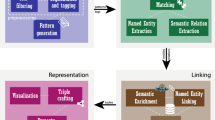Abstract
When semantically describing knowledge graphs (KGs), users have to make a critical choice of a vocabulary (i.e. predicates and resources). The success of KG building is determined by the convergence of shared vocabularies so that meaning can be established. The typical lifecycle for a new KG construction can be defined as follows: nascent phases of graph construction experience terminology divergence, while later phases of graph construction experience terminology convergence and reuse. In this paper, we describe our approach tailoring two AI-based clustering algorithms for recommending predicates (in RDF statements) about resources in the Open Research Knowledge Graph (ORKG) https://orkg.org/. Such a service to recommend existing predicates to semantify new incoming data of scholarly publications is of paramount importance for fostering terminology convergence in the ORKG.
Our experiments show very promising results: a high precision with relatively high recall in linear runtime performance. Furthermore, this work offers novel insights into the predicate groups that automatically accrue loosely as generic semantification patterns for semantification of scholarly knowledge spanning 44 research fields.
Supported by TIB Leibniz Information Centre for Science and Technology, the EU H2020 ERC project ScienceGRaph (GA ID: 819536).
Access this chapter
Tax calculation will be finalised at checkout
Purchases are for personal use only
Similar content being viewed by others
References
Anteghini, M., D’Souza, J., dos Santos, V.A.P.M., Auer, S.: Easy semantification of bioassays (2021). https://arxiv.org/abs/2111.15182
Aryani, A., et al.: A research graph dataset for connecting research data repositories using RD-switchboard. Sci. Data 5, 180099 (2018)
Auer, S., et al.: Improving access to scientific literature with knowledge graphs. Bibliothek Forschung und Praxis 44(3), 516–529 (2020)
Baas, J., Schotten, M., Plume, A., Côté, G., Karimi, R.: Scopus as a curated, high-quality bibliometric data source for academic research in quantitative science studies. Quant. Sci. Stud. 1(1), 377–386 (2020)
Beltagy, I., Lo, K., Cohan, A.: SciBERT: a pretrained language model for scientific text. In: Proceedings of the 2019 Conference on Empirical Methods in Natural Language Processing and the 9th International Joint Conference on Natural Language Processing (EMNLP-IJCNLP), pp. 3606–3611 (2019)
Birkle, C., Pendlebury, D.A., Schnell, J., Adams, J.: Web of science as a data source for research on scientific and scholarly activity. Quant. Sci. Stud. 1(1), 363–376 (2020)
Blei, D.M., Ng, A.Y., Jordan, M.I.: Latent Dirichlet allocation. J. Mach. Learn. Res. 3, 993–1022 (2003)
Buitinck, L., et al.: API design for machine learning software: experiences from the scikit-learn project. In: ECML PKDD Workshop: Languages for Data Mining and Machine Learning, pp. 108–122 (2013)
Dessì, D., Osborne, F., Reforgiato Recupero, D., Buscaldi, D., Motta, E., Sack, H.: AI-KG: an automatically generated knowledge graph of artificial intelligence. In: Pan, J.Z., et al. (eds.) ISWC 2020. LNCS, vol. 12507, pp. 127–143. Springer, Cham (2020). https://doi.org/10.1007/978-3-030-62466-8_9
Fricke, S.: Semantic scholar. J. Med. Libr. Assoc. JMLA 106(1), 145 (2018)
Jin, X., Han, J.: K-means clustering. In: Sammut, C., Webb, G.I. (eds.) Encyclopedia of Machine Learning and Data Mining, pp. 695–697. Springer, Boston (2017). https://doi.org/10.1007/978-1-4899-7687-1_431
Kabongo, S., D’Souza, J., Auer, S.: Automated mining of leaderboards for empirical AI research. In: Ke, H.-R., Lee, C.S., Sugiyama, K. (eds.) ICADL 2021. LNCS, vol. 13133, pp. 453–470. Springer, Cham (2021). https://doi.org/10.1007/978-3-030-91669-5_35
Manghi, P., et al.: OpenAIRE research graph dump, December 2019. https://doi.org/10.5281/zenodo.3516918
Oelen, A., et al.: Covid-19 reproductive number estimates (2020). https://doi.org/10.48366/R44930. https://www.orkg.org/orkg/comparison/R44930
Oelen, A., Jaradeh, M.Y., Stocker, M., Auer, S.: Generate FAIR literature surveys with scholarly knowledge graphs, pp. 97–106. Association for Computing Machinery, New York (2020). https://doi.org/10.1145/3383583.3398520
Pedregosa, F., et al.: Scikit-learn: machine learning in Python. J. Mach. Learn. Res. 12, 2825–2830 (2011)
Sammut, C., Webb, G.I. (eds.): TF-IDF. In: Sammut, C., Webb, G.I. (eds.) Encyclopedia of Machine Learning, pp. 986–987. Springer, Boston (2010). https://doi.org/10.1007/978-0-387-30164-8_832
Wang, K., Shen, Z., Huang, C., Wu, C.H., Dong, Y., Kanakia, A.: Microsoft academic graph: when experts are not enough. Quant. Sci. Stud. 1(1), 396–413 (2020)
Zepeda-Mendoza, M.L., Resendis-Antonio, O.: Hierarchical agglomerative clustering. In: Dubitzky, W., Wolkenhauer, O., Cho, KH., Yokota, H. (eds.) Encyclopedia of Systems Biology, pp. 886–887. Springer, New York (2013). https://doi.org/10.1007/978-1-4419-9863-7_1371
Author information
Authors and Affiliations
Corresponding author
Editor information
Editors and Affiliations
Rights and permissions
Copyright information
© 2022 The Author(s), under exclusive license to Springer Nature Switzerland AG
About this paper
Cite this paper
Arab Oghli, O., D’Souza, J., Auer, S. (2022). Clustering Semantic Predicates in the Open Research Knowledge Graph. In: Tseng, YH., Katsurai, M., Nguyen, H.N. (eds) From Born-Physical to Born-Virtual: Augmenting Intelligence in Digital Libraries. ICADL 2022. Lecture Notes in Computer Science, vol 13636. Springer, Cham. https://doi.org/10.1007/978-3-031-21756-2_39
Download citation
DOI: https://doi.org/10.1007/978-3-031-21756-2_39
Published:
Publisher Name: Springer, Cham
Print ISBN: 978-3-031-21755-5
Online ISBN: 978-3-031-21756-2
eBook Packages: Computer ScienceComputer Science (R0)




